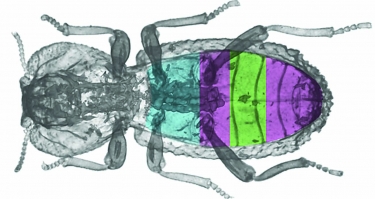By Purdue University
Being run over by a car is not a near-death experience for a diabolical ironclad beetle. How it survives could inspire the development of materials with the same herculean toughness.
These materials would be stiff but ductile like a paper clip, making machinery, such as aircraft gas turbines, safer and longer-lasting.
A study by engineers at Purdue University and University of California, Irvine, found that the toughness of a diabolical ironclad beetle lies in its two armorlike elytra that meet at a line, or suture, running the length of the abdomen.
In flying beetles, the elytra protect wings and facilitate flight. But a diabolical ironclad beetle doesn’t have wings. Instead, the elytra and connective suture help distribute an applied force more evenly throughout the body.
“The suture kind of acts like a jigsaw puzzle,” said Pablo Zavattieri, Jerry M. and Lynda T. Engelhardt professor of civil engineering at Purdue. “It connects various exoskeletal blades — puzzle pieces — in the abdomen under the elytra.”
He said this jigsaw puzzle comes to the rescue in several different ways depending on the amount of force applied.

A CT scan of the diabolical ironclad beetle shows how its organs are spaced beneath a supertough exoskeleton. Image courtesy of University of California, Irvine
To uncover these strategies, a team tested the limits of the exoskeleton and characterized its structural components by looking at CT scans. Using compressive steel plates, researchers found that the beetle can take on an applied force of about 150 newtons (15 kg, or 34 lbs.) — a load of at least 39,000 times its body weight — before the exoskeleton begins to fracture. For comparison, a car tire would apply a force of about 100 newtons (10 kg, or 22 lbs.) if running over the beetle on a dirt surface, researchers estimate. Other tested terrestrial beetles couldn’t handle even half the force that a diabolical ironclad can withstand.
Zavattieri’s lab followed up the experiments with extensive computer simulations and 3D-printed models that isolated certain structures to better understand their roles. The combined studies revealed that when under a compressive load, such as a car tire, the jigsawlike suture offers two lines of defense. First, the interconnecting blades lock to prevent themselves from pulling out of the suture. Second, the suture and blades delaminate, which leads to a more graceful deformation that mitigates catastrophic failure of the exoskeleton. Each strategy dissipates energy to circumvent a fatal impact at the neck, where the exoskeleton is most likely to fracture.
It’s not known yet whether the beetle has a way to heal itself after surviving a major accident. But just knowing about these strategies could solve problems with fatigue in various machinery.
“An active engineering challenge is joining together different materials without limiting their ability to support loads,” said David Restrepo, an assistant professor at University of Texas at San Antonio who worked on this project. “The diabolical ironclad beetle has strategies to circumvent these limitations.”
In gas turbines of aircraft, for example, metals and composite materials are joined by a mechanical fastener that adds weight and introduces stress, which could lead to fractures and corrosion.
Researchers built a carbon-fiber composite fastener mimicking the suture and found that the fastener was as strong as a standard aerospace fastener but significantly tougher.
“This work shows that we may be able to shift from using strong, brittle materials to ones that can be both strong and tough by dissipating energy as they break,” Zavattieri said. “That’s what nature has enabled the diabolical ironclad beetle to do.”
Related Glossary Terms
- fatigue
fatigue
Phenomenon leading to fracture under repeated or fluctuating stresses having a maximum value less than the tensile strength of the material. Fatigue fractures are progressive, beginning as minute cracks that grow under the action of the fluctuating stress.







